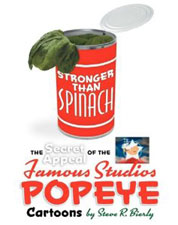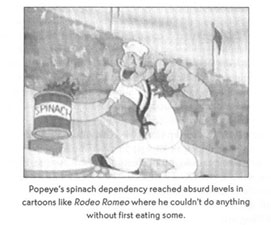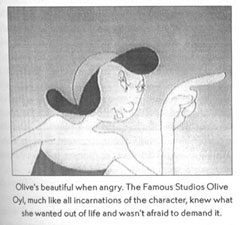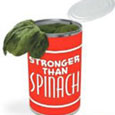 Stronger Than Spinach: The Secret Appeal of The Famous Studios Popeye Cartoons
Stronger Than Spinach: The Secret Appeal of The Famous Studios Popeye Cartoons
By Steve R. Bierly
BearManor Media
November 13, 2009
Softcover, 328 pages
$24.95
Is this the book no one asked for, or the book no one will believe? That’s the question I asked myself repetitively while perusing its pages.
By common consensus, the Fleischer Popeye cartoons of the 1930s are the gold standard for the sailor in animation. Unless you simply hate black and white, there is hardly a bad thing to be said about them. The Fleischer Popeyes were extremely well animated, exciting, inventive, and funny. Along with the original Segar comic strips, the Fleischer cartoons define how we see the sailor and set the standard for quality.
On the other hand, there is… everything else. The TV cartoons get the most negative press, while the Famous Studios version falls in-between. Famous basically grew out of the Fleischer Studio, when their distributor, Paramount, decided to muscle the Fleischers out and simply run a cartoon studio themselves. Many of the same folks stayed on to direct, draw, and act in the cartoons, so one can’t say the personnel was inferior. In fact, had the cartoons stayed under the guidance of the Fleischers, they may have evolved in a similar fashion; we’ll never know. The fact is, they did evolve, and in ways that most would say was not in a positive manner.
Yet, one voice cries out in the wilderness— Steve Bierly. Bierly is a pastor by occupation, so I cannot help being obvious in stating that his book comes off a little like preaching. He wrote the book with one purpose— to “convert” those of us that have held the Famous Popeye cartoons in disdain for so long. Using a deluge of examples, he tries to point out just how much more was going on in those cartoons than we ever appreciated.

He does acknowledge their weaknesses. Yes, they became more formulaic, and Popeye relied more and more on spinach. The animation was also drabber. And yet, there were other qualities that, Bierly contends, made them extremely appealing in their own right. Aside from some increased violence, his main point seems to be that Famous turned Olive Oyl into a sex symbol, and the cartoons in general became more preoccupied with the art of love. Right from the first chapter, he states, “They turned Ms. Oyl into a sexy beauty who could hold her own against any other attractive animated female. Hubba hubba!” Now, if you’re like me, then any disagreement with that statement will likely hinder how much you can buy into Bierly’s view of these cartoons. I can agree that she was prettied up a bit, but… sexy? Tex Avery’s Red was sexy. Olive Oyl never rose much above “mildly agreeable” in my book.
Nevertheless, Bierly re-states his feelings about Ms. Oyl repeatedly throughout the book, which is somewhat necessary for his book’s premise; because without us believing that Olive was totally desirable, the rest of his thesis falls apart. Regardless, he makes the valid point that the rather unsophisticated grab & snatch “romance” of the Fleischer shorts was replaced by a whole lot more wooing. He mentions seeing more lust, love, and late Forties and 1950s-style romance in the Famous cartoons. This may be so. I just could never quite get over his constant references to Olive being a “hot babe.” It borders on creepy, while being oh-so-contrary to popular opinion.

Aside from his Olive fixation, he does spend time deconstructing Popeye and Bluto. Here, it seems Bierly clearly favors Bluto (note that when he says “Bluto” he is really referring to all of Popeye’s adversaries in the cartoons). Popeye is given his due for all his well-known attributes of righteousness and loyalty, but he is also depicted as being weak, unattractive, stupid, easily victimized, and even “square.” Again, these statements are often true in these cartoons, but this doesn’t seem to support the argument that the cartoons hold special appeal… until Bierly discusses Bluto, with whom he is clearly impressed. He refers to Bluto and Olive as “”the hottest animated stars of all time!” During my reading of the book, I couldn’t decide if Bierly was more in love with Olive or Bluto, who is described as having all the qualities that Popeye lacked— handsome, muscle-bound, clever, attentive, and— above all— not dependent on spinach. Even when he admits that Bluto can be a lout, he does so apologetically, with a sense of absolution. Bierly’s viewpoint only wavers when discussing Bluto’s one fatal flaw: impatience. In Bierly’s view, greater patience would have always allowed Bluto to win Olive and beat Popeye every time.
His admiration of Bluto, though, does indeed play second fiddle to how he is enamoured with Olive. He even loves her bad qualities. “The roving eye of the Famous Studios Olive could also be seen as an aspect of her appealing personality, rather than a character defect.” Really? I just can’t relate to statements like that one. Personally, I often felt that Popeye was thrilled with a girl that he shouldn’t have been, and we’ve all been there. I wouldn’t really glamorize Olive for her shortcomings.
Much of the text, at least in the early going, contains material that will come as no surprise to cartoon fans… such as explaining that characters’ appearances changed between cartoons because different artists worked on them. Or that the voice artists contributed a lot to the cartoons. So did the music. So did the directors. And the writers. And so on. Such rudimentary remarks seem out of place in a book that spends much more time discussing the, uh, intimacy of human relationships. (At one point, he even warns the reader to have a cold shower.) He also has the habit of speaking for the larger audience, with such statements as “Some of us began to ask questions of the cartoons…” or “viewers started to root for Bluto.” It’s a writing style that I personally find a little annoying, since we know he didn’t really poll all of us to find out what we were thinking while watching these cartoons as children. Worse, I found many of these remarks decidedly off the mark.

Seventy pages into the book, I found myself unable to relate to the author’s point of view, and wasn’t buying into his arguments. It’s funny, but I have another “Pastor Steve” in my life. He’s my next-door neighbor— an excellent fellow, who has given me a lot of help with various projects over the years. He’s also a Star Wars nut. In this case, I can totally relate with my Pastor Steve. Love of Star Wars seems entirely rational to me. That, I can buy into. Pastor Steve Bierly’s views on the Famous Popeyes just fail to convince me. He sure does try, though.
The next 130 pages examine several of the cartoons in detail. Lots of detail. If Bierly didn’t have me with his relatively concise essays that appeared earlier in the book, he sure didn’t get me with the extended synopses of the cartoons. It turns out, which will surprise no one, that watching a seven minute cartoon is much more fun than reading a twelve page description of it. The next 85 pages describe each of the remaining dozens of cartoons in lesser (albeit more palatable) detail. All of it might be more palatable if there were some decent pictures to view. Unfortunately, all that appears are some rather washed-out, low-resolution screen grabs that look like they came from taking a photo off a television running a VHS tape (likely the case, as these cartoons are largely not available on DVD). I understand the need for the images to be in black and white, due to publishing costs, but it’s unfortunate that the images could not have been better; or, if nothing else, more numerous. Constantly, Bierly strains to tell us how gorgeous Olive is in a particular cartoon, or how handsome Bluto is, with no evidence in sight.
Appendix A goes unnecessarily further, discussing the King Features Syndicate television cartoons of the 1960s, including short synopses of nine of those cartoons. Appendix B sees Bierly talking about random things in pop culture that remind him of his beloved Popeye cartoons, including Honeymoon In Vegas, and an Archie comic book. He also summarizes a couple of the Popeye comic books. And, just to make sure that I finish the book in a really disagreeable mood, he brings up the atrocious Superman Returns, where he compares Kryptonite-poisoned Superman to spinach-deprived Popeye. (Of all the times this has happened in the comics, cartoons, and movies, why on Earth would he have to bring up the despised Superman Returns?)
Bierly does make a number of sound points about the Famous cartoons. I just don’t see how his ideas justified this book’s existence. An enthusiastic post on an Internet message board might have sufficed. With little to offer beyond some remarks about Olive Oyl being sexy, and Bluto being a better man than Popeye, plus a whole pile of not-so-interesting plot synopses, I can’t say there’s much here to recommend. Better use of images would have helped immensely, but in the end the text just isn’t all that involving. Bierly obviously has enthusiasm for these cartoons, but his writing efforts may have been better directed elsewhere.



